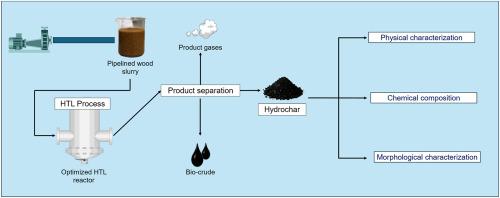管道输送软木生物质水热液化制烃类的生产与表征
IF 5.8
2区 生物学
Q1 AGRICULTURAL ENGINEERING
引用次数: 0
摘要
本研究研究了管道输送软木生物质的水热液化(HTL)制氢。以水为载体的生物质管道运输是卡车运输的一种经济有效的替代方案,其与HTL相结合用于碳氢化合物生产的研究相对较少。本研究的目的是评估工艺参数对管道生物质HTL的影响,并表征所得到的各种应用的碳氢化合物。在最佳工艺条件下,管道生物质生产的碳氢化合物的产率为13.22%(以烘箱干质量为基础),其中19.31%的能量从碳氢化合物中回收。该烃类为黑色、易碎、弱酸性碳材料,干堆积密度为0.142 g/cm3,碳含量提高,比表面积增加(9.27 m2/g),孔隙形态改变,呈石墨化、无定形结构,反映了HTL过程中结构和成分的变化。研究发现,管道处理对软木生物质的木质纤维素成分和颗粒大小的影响很小,但它会导致无机元素的浸出,从而降低碳氢化合物中的灰分含量。表征结果表明,该烃类适合用于土壤改良剂和固体燃料;它的低表面积阻碍了它作为吸附剂或能量储存的使用。因此,这项研究证明了将水力运输与HTL相结合的潜力,为各种应用提供了回收、管理和使用碳氢化合物的途径。本文章由计算机程序翻译,如有差异,请以英文原文为准。

Production and characterization of hydrochar produced from hydrothermal liquefaction of pipeline-transported softwood biomass
This study investigates hydrochar production from hydrothermal liquefaction (HTL) of pipeline-transported softwood biomass. Pipelining biomass using water as a carrier fluid offers a cost-effective alternative to truck transport, and its integration with HTL for hydrochar production is relatively unexplored. The objective of this study was to evaluate the effect of process parameters on HTL of pipelined biomass and characterize the resulting hydrochar for various applications. The yield of hydrochar produced from pipelined biomass, at the optimal process conditions, was 13.22 % (oven-dry mass basis), with 19.31 % of energy recovered in hydrochar. The hydrochar was characterized as a black, fragile, mildly acidic carbon material with a dry bulk density of 0.142 g/cm3, improved carbon content, increased surface area (9.27 m2/g), altered pore morphology, and a graphitized, amorphous structure, reflecting structural and compositional changes from the HTL process. Pipelining was found to have minimal impact on the lignocellulosic composition and particle size of the softwood biomass, but it resulted in the leaching of inorganic elements, leading to a reduction in ash content in the hydrochar. The characterization results suggest the hydrochar is suitable for soil amendment and solid fuel applications; its low surface area hinders its use as an adsorbent or for energy storage. This study thus demonstrates the potential of integrating hydro-transportation with HTL, offering a pathway to recover, manage, and use hydrochar for various applications.
求助全文
通过发布文献求助,成功后即可免费获取论文全文。
去求助
来源期刊

Biomass & Bioenergy
工程技术-能源与燃料
CiteScore
11.50
自引率
3.30%
发文量
258
审稿时长
60 days
期刊介绍:
Biomass & Bioenergy is an international journal publishing original research papers and short communications, review articles and case studies on biological resources, chemical and biological processes, and biomass products for new renewable sources of energy and materials.
The scope of the journal extends to the environmental, management and economic aspects of biomass and bioenergy.
Key areas covered by the journal:
• Biomass: sources, energy crop production processes, genetic improvements, composition. Please note that research on these biomass subjects must be linked directly to bioenergy generation.
• Biological Residues: residues/rests from agricultural production, forestry and plantations (palm, sugar etc), processing industries, and municipal sources (MSW). Papers on the use of biomass residues through innovative processes/technological novelty and/or consideration of feedstock/system sustainability (or unsustainability) are welcomed. However waste treatment processes and pollution control or mitigation which are only tangentially related to bioenergy are not in the scope of the journal, as they are more suited to publications in the environmental arena. Papers that describe conventional waste streams (ie well described in existing literature) that do not empirically address ''new'' added value from the process are not suitable for submission to the journal.
• Bioenergy Processes: fermentations, thermochemical conversions, liquid and gaseous fuels, and petrochemical substitutes
• Bioenergy Utilization: direct combustion, gasification, electricity production, chemical processes, and by-product remediation
• Biomass and the Environment: carbon cycle, the net energy efficiency of bioenergy systems, assessment of sustainability, and biodiversity issues.
 求助内容:
求助内容: 应助结果提醒方式:
应助结果提醒方式:


